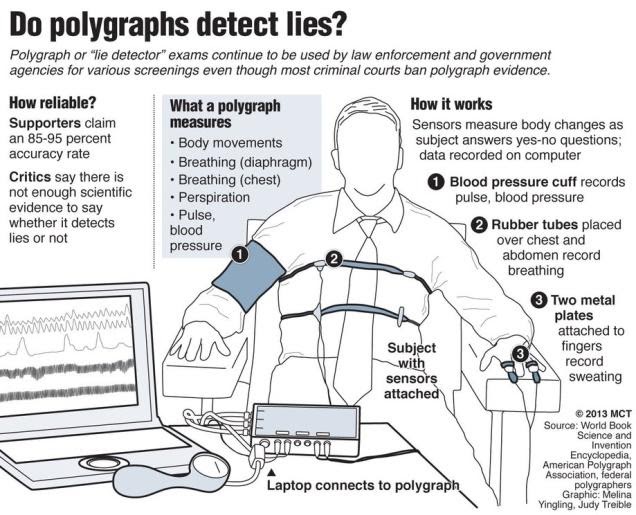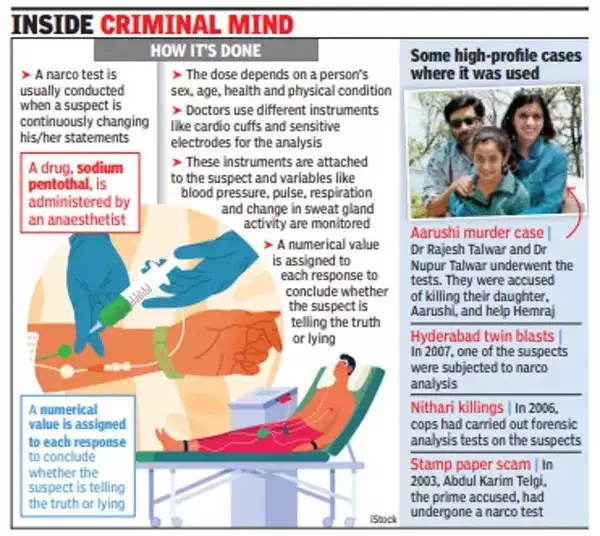- Home
- Prelims
- Mains
- Current Affairs
- Study Materials
- Test Series
What are narco-analysis, polygraph test and brain-mapping?
Polygraph or Lie Detector Test:It is a procedure that measures and records several physiological indicators such as blood pressure, pulse, respiration, and skin conductivity while a person is asked and answers a series of questions.
-
- This test is based on the assumptionthat physiological responses that are triggered when a person is lying are different from what they would be otherwise.
- A numerical value is assignedto each response to conclude whether the person is telling the truth, is deceiving, or is uncertain.
- A test similar to Polygraph was first done in the 19th century by the Italian criminologist Cesare Lombroso, who used a machine to measure changes in the blood pressure of criminal suspects during interrogation.

Narcoanalysis Test: It involves the injection of a drug, sodium pentothal, which induces a hypnotic or sedated state in which the subject’s imagination is neutralized, and they are expected to divulge information that is true. A few of the best-known drugs that are used in the narco analysis test are as follows:
- Seconal
- Hyoscine (scopolamine)
- Sodium Pentothal
- Sodium Amytal
- Phenobarbital
- The most commonly used drug for truth serum tests is an anaesthetic and sedative drug, Sodium Pentothal, which when administered intravenously can make a person talkative and confessional.
- When these drugs are injected in continuous small dosages, it might have a hypnotizing effect on a person, who responds loquaciously when questioned.
- The narcoanalysis test is conducted by mixing 3 grams of Sodium Pentothal or Sodium Amytal dissolved in 3000 ml of distilled water.
- Depending on the person’s sex, age, health and physical condition, this mixture is administered intravenously along with 10% of dextrose over a period of 3 hours with the help of an anaesthetist.
- The wrong dose can send the person into a coma or even cause death.
- Effects of the drugs on the persons can be any one of these or all of these.
- After administering a truth drug, a person’s body turns into cozy, his or her features slacken and full of exhilaration and few grow to be silly and giggly.
- The drug blocks the impulses that commonly pass through positive nerves and maximum body parts fall asleep, which emerge later in disoriented semi-wakefulness.
- Under the effect of drugs, he/she turns incapable of telling a lie, and he/she will always share any records that are asked of them.

Brain Mapping Test or P-300 test: In this test, the activity of the brain of a suspect is measured during interrogation to find out whether he is concealing any information.
- Brain-mapping is a comprehensive analysis of brainwave frequency bandwidths. In this test, forensic experts apply unique neuroscience techniques to find out if a suspect''s brain recognises things from a crime scene which an innocent person''s brain will have no knowledge of.
- In brain-mapping, sensors are attached to the suspect''s head and he or she is made to sit in front of a computer screen. The suspect is then made to see images or hear sounds.
- The sensors monitor electrical activity in the brain and register certain waves which are generated only if the suspect has any connection with the stimulus (image or sound).
 Limitations:
Limitations:
-
- None of these methodshas been proven scientifically to have a 100% success rate, and remain contentious in the medical field as well.
- The consequences of such tests on individuals from weaker sections of society who are unaware of their fundamental rights and unable to afford legal advice can be adverse.
- It may involve future abuse, harassment, and surveillance,even leakage of the video material to the Press for a trial by the media.
- Legal and Constitutional Aspects:
- In the Selvi vs State of Karnataka & Anr case (2010), the Supreme Court ruled that no lie detector tests should be administered without the consent of the accused.
- Also, those who volunteer must have access to a lawyer and have the physical, emotional, and legal implications of the test explained to them by police and the lawyer.
- The results of the tests cannot be considered to be "confessions",but any information or material subsequently discovered with the help of such a voluntarily-taken test can be admitted as evidence
- The SC cited Article 20 (3) or Right against self-incrimination whichstates that no accused can be compelled to be a witness against himself.
- In the K. Basu vs. State of West Bengal case, 1997, the SC ruled that involuntary administration of the polygraph and narcos test will amount to cruel, inhuman, and degrading treatment in the context of Article 21 or the Right to Life and Liberty.
- It may also be violative of the Right to Privacy which is a part of the Right to Life.
- The Indian Evidence Act, 1871does not admit the results of these tests as evidence.
- In the Selvi vs State of Karnataka & Anr case (2010), the Supreme Court ruled that no lie detector tests should be administered without the consent of the accused.
- The National Human Rights Commission in 1999 adopted a set of guidelines relating to the administration of the Polygraph Test which included consent, recording of the test, etc.
Looking ahead
- These methods cannot be used as incriminating evidence or confessions due to their limited reliability and scientific proofs. However, they can be used as useful tools to solve complicated cases as investigative tools. The government should encourage the use of scientific techniques in the otherwise long investigative procedures and trials but should also come up with strict rules for their use in a decent, and consensual manner.









 Latest News
Latest News
 General Studies
General Studies